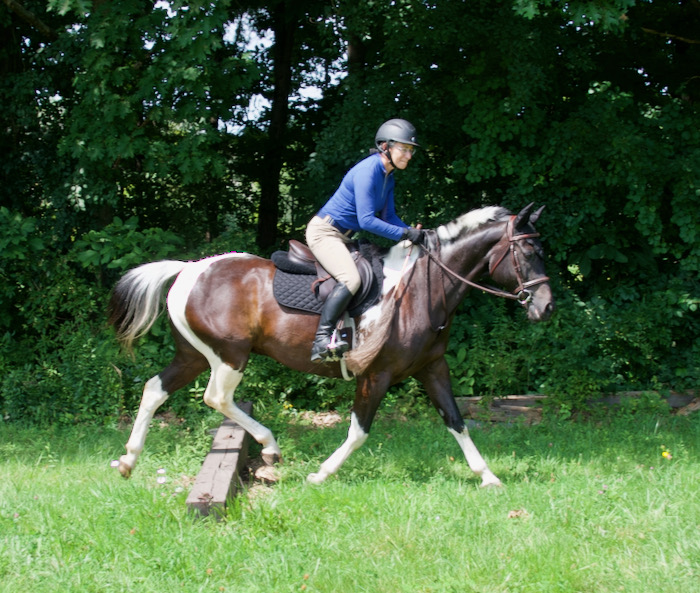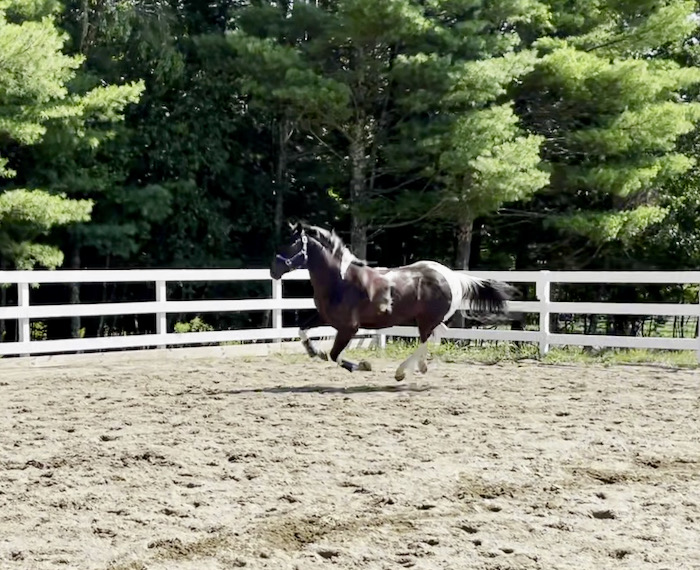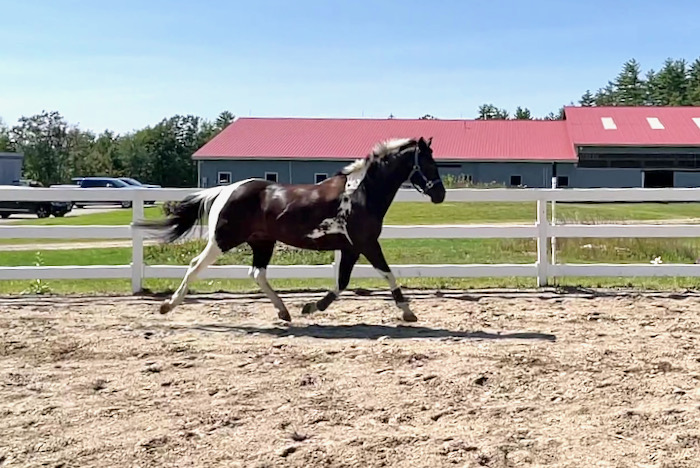For the last four years, Tonka has been intermittently off on the left front. Trotted out on a hard surface and turned sharply to the left, he shows a head bob – a sign that there’s something going on that is ouchy. Most of the time though, that’s it. On good footing in the ring, and out on the trail he goes steady and even. Once in awhile, though, he head bobs on the short side of the ring. Sometimes he has difficulty with canter transitions. X-rays show a healthy foot. Good angles. No arthritis. Front shoes with supportive pads made a difference and reduced the instances of head bobbing. Injecting the coffin joints with a cocktail of medications seemed to alleviate whatever was causing an occasional twinge. Other protocols also help to keep Tonka going soundly. Shockwave on his neck and across his back takes care of aches and pains due to arthritis and old injuries. Keeping him fit, especially with hill work and pole exercises, has Tonka using his body correctly and athletically so that he looks like this.

But in the last two weeks that left front issue hasn’t been so intermittent. For the last couple of rides he’s been consistently head bobbing. It’s time to get to the root of this. My vet will evaluate Tonka on Wednesday. However, there are only so many diagnostics that a vet can do at the barn – especially with a horse that shows only the mildest of symptoms whenever the vet is checking him out! I think we’ll be scheduling a road trip to Tufts for an MRI.
Yesterday I thought I’d free-lunge Tonka to get a video of the head bobbing. Tonka was so lame the day before that I figured he’d slowly trot around while I recorded his gaits. It would be a useful video for a consulting vet to see.
Of course, things didn’t go according to plan. First there was some of this. Please note that Tonka had already been turned out in a spacious paddock all day. He was just showing off.

The trot looked marvelous. I should be thrilled that there was no sign that Tonka had any soreness anywhere, least of all in the front left leg.

Those fancy gaits can fool you. Sometimes lame horses look sound when they’re cavorting around. The adrenalin masks pain. But once Tonka settled down, he still looked good.
Still, he’s got an intermittent left front lameness. I want to know why, and I want to fix it. Hopefully, modern diagnostic tools will give us the answer. I’ll keep you informed! Have you had a lameness issue like this? Inconsistent and difficult to diagnose? Tell me about it in the comments!


just curious, I know very little about horses I wish I knew what the head bob looked like, have you ever consulted with a homeopathic veterinarian ?
I wish I had that video for you to show the head bob! When the horse puts weight on the ouchy foot, they raise their head to try to counterbalance and not step so hard. So, as they trot, it looks like they’re bobbing their head.
I’ll be blunt about homeopathy – I don’t think that it has any validity other than the placebo affect.
A certain, very opinionated paint mare just spent most of her summer at Tufts…ugh. Good luck with getting that left front sorted out!
I was just thinking about you! I suppose I should be glad to hear that Angel is as opinionated as ever??? 🙂
I hope you figure out the problem quickly so you can get him sound again. My last horse was just like that. It’s so hard with animals; you can’t ask where they hurt. You just keep ruling things out until you find the answer. An MRI will be so helpful.
I’m grateful that I’m within a 2-hour drive of such technology and world-class veterinary services.
Perhaps perplexing more than difficult to diagnose in my case, but mare in my case with underrun heels all around, worse in front, where the right front looks the worst (negative palmar angle, thin sole, etc.) but she is off, to varying degrees depending on the day, surface and whether she’s going in a right circle or not, on the left front. It forced me to learn more about hooves and also drove home the need to rule out discomfort when contemplating perceived behavioral issues, plus we caught it fairly early, so all in all probably a blessing for the long term.
Yes! Always look for pain as a source of behavioral issues. Hopefully you have a good farrier to help you with your mare. She’ll be so grateful to have her hoofs set right.
Honestly, sometimes I think the best way to cure a lameness is to simply schedule a vet appointment. The more expensive the appointment and tests, the more dramatic the cure. (Kidding aside, I wish you luck in sorting it out!)
I actually have a line in my budget for “unexpected veterinary expenses” 🙂
My horse has a bone spur that causes that. Inoperable and difficult to diagnose
That diagnosis has crossed my mind. Sorry you have to cope with that.